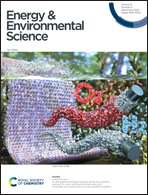Confined interface transformation of metal–organic frameworks for highly efficient oxygen evolution reactions†
Abstract
Metal–organic frameworks (MOFs) offer high flexibility for the regulation of coordination structures and compositions for various promising applications. However, the real properties of a single MOF are highly dependent on the morphology and surface chemistry for specific applications. Herein, an in situ confined interface transformation process to spontaneously manipulate the diverse morphology and surface composition of a single bulk MOF electrodeposited was realized via a mass transport limited deposition process. The regulation of the mass transport process including electromigration, diffusion and forced diffusion allows the manipulation of interfacial ion–ligand concentrations for the conversion between dissolution and precipitation, which endows the interface with the ability to regulate the morphology and composition for diverting chemistry. In particular, interfacial etching and in situ precipitation processes enable the formation of Fe-trimesic acid nanodot-embedded nanorods with superior oxygen evolution activity and remarkable long-term durability over 800 h. Operando probing of intermediates via reactions with nucleophiles verifies that the favorable surface chemistry of hierarchical composite structures would optimize the binding energy for intermediate formation. The uncoordinated carboxylates serve as proton transfer relays, accelerating the proton transfer process and boosting the oxygen evolution performance. Furthermore, to address the potential safety hazard, ferricyanide was used as a proton-independent electron reservoir to decouple water electrolysis for favorable energy conversion in an electrolyzer design. This facile, scalable, and cost-effective interface transformation strategy offers spontaneous control over the MOF structure and composition for desirable electrocatalysis.



 Please wait while we load your content...
Please wait while we load your content...